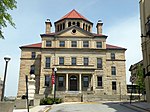Washington County Courthouse (Pennsylvania)
Beaux-Arts architecture in PennsylvaniaBuildings and structures in Washington County, PennsylvaniaCounty courthouses in PennsylvaniaCourthouses on the National Register of Historic Places in PennsylvaniaFrederick J. Osterling buildings ... and 4 more
Government buildings completed in 1900National Register of Historic Places in Washington County, PennsylvaniaWashington, PennsylvaniaWashington County, Pennsylvania Registered Historic Place stubs

The Washington County Courthouse is located in downtown Washington, Pennsylvania, United States. It was listed on the National Register of Historic Places on July 30, 1974. It is designated as a historic public landmark by the Washington County History & Landmarks Foundation.On April 14, 1980, during the Presidential primary, Vice President Walter Mondale visited the courthouse for a campaign rally, calling out Democratic foe Ted Kennedy.
Excerpt from the Wikipedia article Washington County Courthouse (Pennsylvania) (License: CC BY-SA 3.0, Authors, Images).Washington County Courthouse (Pennsylvania)
West Beau Street,
Geographical coordinates (GPS) Address Nearby Places Show on map
Geographical coordinates (GPS)
| Latitude | Longitude |
|---|---|
| N 40.17045 ° | E -80.245802777778 ° |
Address
Washington County Courthouse
West Beau Street
15301
Pennsylvania, United States
Open on Google Maps











